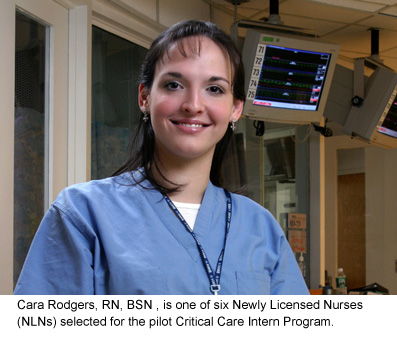Novice Nurses Learn the Ropes of the ICU

WH expanded opportunities for newly licensed nurses (NLNs) within the critical care nursing team. The five-month Critical Care Intern Program is based on Patricia Benner’s novice-to-expert model. Critical care knowledge and skills are built by slowly increasing the complexity of clinical assignments over time. In the Critical Care Intern Program, nurses are oriented carefully to this highly specialized patient care setting.
Before this program, Cara Rodgers, RN, BSN, only would have been eligible to work on one of the med/surg floors, but because of this training, she soon will begin as a staff nurse in the Cardiac Surgical ICU on 8C.
“I was highly impressed by the professionalism and teamwork exhibited by HR and the nurses on 8C in recruiting me,” said Rodgers, a June 2004 graduate of Case Western Reserve University.
Rodgers and five other NLNs were selected to be part of the pilot program. All six follow the curriculum developed by Mary Pennington, RN, MSN, CCRN, the program’s coordinator, former Neuro ICU educator and longtime BWH nurse. These newly licensed nurses spend four weeks in the “primer program” on a BWH med/surg floor. The goal is for them to acquire a working ‘hands-on’ knowledge of the staff nurse’s role and responsibilities in a positive and professional environment. During the program primer, these newly licensed nurses gain first-hand experience with the automated patient care systems and independently implement care to low-end acuity patients with teaching and learning resources readily available.
After the NLNs complete their primer, they spend two weeks in classes learning fundamental critical care concepts. In week seven, NLNs go to their designated critical care unit where each works one-on-one with carefully selected clinical colleagues on various shifts to gain firsthand ICU experience. This hands-on experience is reinforced with weekly classroom instruction and regular meetings with Pennington.
“The hands-on experience I’m gaining alongside my preceptors is truly priceless,” said Rodgers. Her 8C day preceptors include Theresa Todesco, RN, BSN, and Peter Dort, RN, and her night preceptors include Brenda Thames, RN, and Roger Blanza, RN, BSN.
The five-month pilot program wraps up at the end of this month. “Participants told us they underestimated the challenge of critical care nursing,” said Pennington, who created the program to provide critical care learning opportunities for new graduates and to address the current job market. Last year, 40 percent of BWH’s new hires were NLNs.
The ICU is following the lead of other BWH specialty areas such as the Emergency Department and the Operating Room now offering similar NLN training programs. In addition to Rodgers, NLNs are joining critical care units on 11C (Thoracic ICU), 9C (Medical ICU), 9D (Neuro ICU) and 12D (Critical Care Unit).
Pennington hopes to build the program from the foundation of this first pilot. “The most important supports identified by the NLNs for enhancing their success in this program were: a supportive preceptor, weekly classes with the whole NLN group, the primer program, being with other NLNs orienting to the ICU and having exposure to an ICU as a student,” she said.
“So far, we are seeing the program’s success come from not only the NLN selected and but also the relationship with the preceptor. The level of exchange between inexperienced and veteran nurses will ensure consistent, high quality critical care at BWH,” she said.
To learn more about the Critical Care Intern Program contact Mary Pennington at ext. 2-7042 or via email (mpennington@partners.org).